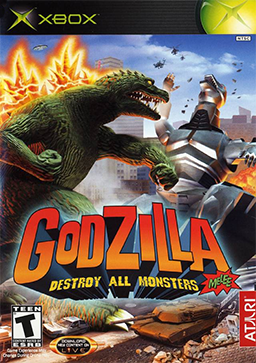Godzilla: Destroy All Monsters Melee
| Godzilla: Destroy All Monsters Melee | |
|---|---|
 Cover art for the North American Xbox version. | |
| Developer(s) | Pipeworks Software |
| Publisher(s) | Atari DreamWorks Classics Toho |
| Platform(s) | Nintendo GameCube, Xbox |
| Release | GameCube[1] Xbox [2] |
| Genre(s) | Fighting |
| Mode(s) | Single-player, Multiplayer |
Godzilla: Destroy All Monsters Melee is a fighting video game produced by Pipeworks Software, Inc. and released for the Nintendo GameCube on October 8 and November 15 in North America and Europe respectively. The game was later released for the Xbox with additional content in North America and Europe in April and May 2003 respectively. A planned PlayStation 2 release was cancelled. The plot involves an alien race known as the Vortaak invading the Earth and assuming control of the planet's giant monsters, sending them to attack cities across the globe. One monster breaks free from the Vortaak's control, and battles the other monsters in order to drive off the Vortaak.
Gameplay
The player plays as a one of several giant monsters (eleven playable characters: Anguirus, Destoroyah, Gigan, Godzilla 90s, Godzilla 2000, King Ghidorah, Mecha-King Ghidorah, Megalon, Orga, Rodan, and Mechagodzilla). Via punches, kicks, and limb attacks (usually a tail-attack), each monster can attack others and also use their surroundings. Army forces (missile and "freeze" tanks) and the monster Hedorah (which slows a monster's energy regeneration ability) are also present and sporadically attack all monsters. Extras include bonus orbs, which can provide a finishing move or summon the monster Mothra for an airstrike. Extra features include choice of several locations, and a "destruction" mode (in which players compete to destroy buildings in a city) and "melee" mode (in which up to four players can compete simultaneously).
Playable Characters
Excellent defense, good speed, medium attack and weapons; already unlocked.
Excellent weapons, good attack and defense, bad speed; Unlocked by Godzilla 2000.
Excellent speed, good attack, medium defense and weapons; Unlocked by Megalon or already unlocked.
- Godzilla 90's
Good attack and weapons, medium defense and speed; already unlocked.
- Godzilla 2000
Good attack and speed, medium defense and weapons; Unlocked by Godzilla 90's.
Excellent attack and defense, good weapons, bad speed; Unlocked by Gigan or Megalon.
Excellent defense and weapons, medium attack and speed; Unlocked by Mecha-King Ghidorah when all other monsters are unlocked (except Orga).
Good attack, defense and speed, medium weapons; Japanese GameCube and Xbox versions only; Unlocked by Mecha-King Ghidorah when all other monsters are unlocked (Except Orga), or by beating the game on hard mode with Orga after unlocking all other monsters.
Excellent weapons, good attack and defense, bad speed; Unlocked by Rodan or King Ghidorah.
Good attack, speed and weapons, bad defense; already unlocked.
Excellent attack, good defense, medium speed and weapons; Unlocked by Godzilla 2000 when all other monsters are unlocked (with the possible exception of Mechagodzilla 3) and have beaten Adventure Mode.
Excellent speed, medium weapons, bad attack and defense; Unlocked by King Ghidorah, Gigan and Anguirus.
Non-playable
Summonable assistant.
Randomly appearing enemy; slows down energy regeneration.
Scrapped
Was to be included as a PS2 exclusive, which was scrapped.
Due to his similarities to Ultraman.
- Showa Mechagodzilla
Scrapped in the favor of the Heisei Mechagodzilla.
Due to the fact that there were two Godzillas already.
- Godzilla 1954
Same as SpaceGodzilla.
- Kiryu (USA GameCube version)
Godzilla Against Mechagodzilla was not released outside of Japan yet the character was playable on the Xbox and Japanese GameCube versions of the game.
Was scrapped due to being almost impossible to be made in the game's engine. Biollante was also scrapped for Godzilla: Save The Earth, but was available by modifying the game or using cheat codes. She finally made an appearance in Godzilla Unleashed.
- ShowaMoguera
All of the monsters (except for Godzilla 1954, Biollante, Showa Moguera and Showa Mechagodzilla) appeared in the sequel Godzilla: Save the Earth. Showa Moguera has never made an appearance in a Godzilla game.
Critical reception
Both versions of the game received positive reviews from critics. On the review aggregator Game Rankings, the GameCube version of the game received an average score of 74% (based on 36 reviews).[1] On Metacritic, the game received an average score of 73% (based on 30 reviews).[3] IGN gave it a score of 8.4 out of 10 calling it "one of GameCube's very best". The Xbox version received similar reviews.
Version differences
The US version of the GameCube version has Mechagodzilla 2, while the Japanese version has Mechagodzilla 3 (Kiryu). The Xbox version contains both versions of Mechagodzilla, improved graphics, two new fighting arenas (Boxing Ring, Vortaak Homeworld) and custom soundtracks.
References
- ^ a b "Godzilla: Destroy All Monsters Melee Reviews (GameCube)". Game Rankings. Retrieved 2008-03-19.
- ^ "Release information for Xbox". GameFAQs.
- ^ "Godzilla: Destroy All Monsters Melee (cube: 2002): Reviews". Metacritic. Retrieved 2008-03-19.
